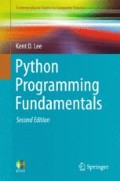Abstract
Python is an object-oriented language. This means, not only can we use objects, but we can define our own classes of objects. A class is just another name for a type in Python. We have been working with types (i.e. classes) since the first chapter of the text. Examples of classes are int, str, bool, float and list.
Access this chapter
Tax calculation will be finalised at checkout
Purchases are for personal use only
Author information
Authors and Affiliations
Corresponding author
Rights and permissions
Copyright information
© 2014 Springer-Verlag London
About this chapter
Cite this chapter
Lee, K.D. (2014). Defining Classes. In: Python Programming Fundamentals. Undergraduate Topics in Computer Science. Springer, London. https://doi.org/10.1007/978-1-4471-6642-9_7
Download citation
DOI: https://doi.org/10.1007/978-1-4471-6642-9_7
Publisher Name: Springer, London
Print ISBN: 978-1-4471-6641-2
Online ISBN: 978-1-4471-6642-9
eBook Packages: Computer ScienceComputer Science (R0)

